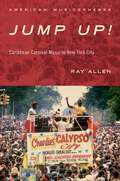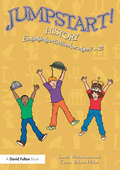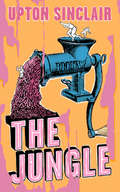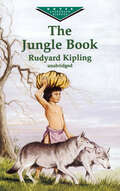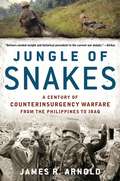- Table View
- List View
Jump-Starting America: How Breakthrough Science Can Revive Economic Growth and the American Dream
by Simon Johnson Jonathan GruberThe untold story of how America once created the most successful economy the world has ever seen and how we can do it again. The American economy glitters on the outside, but the reality is quite different. Job opportunities and economic growth are increasingly concentrated in a few crowded coastal enclaves. Corporations and investors are disproportionately developing technologies that benefit the wealthiest Americans in the most prosperous areas -- and destroying middle class jobs elsewhere. To turn this tide, we must look to a brilliant and all-but-forgotten American success story and embark on a plan that will create the industries of the future -- and the jobs that go with them. Beginning in 1940, massive public investment generated breakthroughs in science and technology that first helped win WWII and then created the most successful economy the world has ever seen. Private enterprise then built on these breakthroughs to create new industries -- such as radar, jet engines, digital computers, mobile telecommunications, life-saving medicines, and the internet-- that became the catalyst for broader economic growth that generated millions of good jobs. We lifted almost all boats, not just the yachts. Jonathan Gruber and Simon Johnson tell the story of this first American growth engine and provide the blueprint for a second. It's a visionary, pragmatic, sure-to-be controversial plan that will lead to job growth and a new American economy in places now left behind.
Jump Up!: Caribbean Carnival Music in New York (American Musicspheres)
by Ray AllenJump Up! Caribbean Carnival Music in New York City is the first comprehensive history of Trinidadian calypso and steelband music in the diaspora. Carnival, transplanted from Trinidad to Harlem in the 1930s and to Brooklyn in the late 1960s, provides the cultural context for the study. Blending oral history, archival research, and ethnography, Jump Up! examines how members of New York's diverse Anglophile-Caribbean communities forged transnational identities through the self-conscious embrace and transformation of select Carnival music styles and performances. The work fills a significant void in our understanding of how Caribbean Carnival music-specifically calypso, soca (soul/calypso), and steelband-evolved in the second half of the twentieth century as it flowed between its Island homeland and its bourgeoning New York migrant community. Jump Up! addresses the issues of music, migration, and identity head on, exploring the complex cycling of musical practices and the back-and-forth movement of singers, musicians, arrangers, producers, and cultural entrepreneurs between New York's diasporic communities and the Caribbean.
JUMP UP! AM C: Caribbean Carnival Music in New York (American Musicspheres)
by Ray AllenJump Up! Caribbean Carnival Music in New York City is the first comprehensive history of Trinidadian calypso and steelband music in the diaspora. Carnival, transplanted from Trinidad to Harlem in the 1930s and to Brooklyn in the late 1960s, provides the cultural context for the study. Blending oral history, archival research, and ethnography, Jump Up! examines how members of New York's diverse Anglophile-Caribbean communities forged transnational identities through the self-conscious embrace and transformation of select Carnival music styles and performances. The work fills a significant void in our understanding of how Caribbean Carnival music-specifically calypso, soca (soul/calypso), and steelband-evolved in the second half of the twentieth century as it flowed between its Island homeland and its bourgeoning New York migrant community. Jump Up! addresses the issues of music, migration, and identity head on, exploring the complex cycling of musical practices and the back-and-forth movement of singers, musicians, arrangers, producers, and cultural entrepreneurs between New York's diasporic communities and the Caribbean.
Jumpin' Jack Flash: David Litvinoff and the Rock’n’Roll Underworld
by Keiron Pim'REVELATORY' - DAILY TELEGRAPH *****'FASCINATING' - OBSERVER'ENGROSSING' - DAILY MAIL'You’ll worry at your hunger to keep on reading, but you won’t be able to stop' - GUARDIAN, Book of the Year David Litvinoff was one of the great mythic characters of ‘60s London. Flitting between the worlds of music, art and crime, he exerted a hidden influence that helped create the Krays twins’ legend, connected the Rolling Stones with London’s dark side, shaped the plot of classic film Performance – and saw him immortalised in a portrait by Lucian Freud. Litvinoff’s determination to live without trace means that his life has always eluded biographers, until now. Intent on unravelling the enigma of Litvinoff, Keiron Pim conducted 100 interviews over five years, speaking to Eric Clapton and Marianne Faithfull, James Fox and ‘Mad’ Frankie Fraser. The result is an extraordinary feat of research that traces a rogue’s progress amongst aristocrats, gangsters and rock stars.
Jumpin' Jim Crow: Southern Politics from Civil War to Civil Rights
by Jane Dailey Glenda Elizabeth Gilmore Bryant SimonWhite supremacy shaped all aspects of post-Civil War southern life, yet its power was never complete or total. The form of segregation and subjection nicknamed Jim Crow constantly had to remake itself over time even as white southern politicians struggled to extend its grip. Here, some of the most innovative scholars of southern history question Jim Crow's sway, evolution, and methods over the course of a century. These essays bring to life the southern men and women--some heroic and decent, others mean and sinister, most a mixture of both--who supported and challenged Jim Crow, showing that white supremacy always had to prove its power. Jim Crow was always in motion, always adjusting to meet resistance and defiance by both African Americans and whites. Sometimes white supremacists responded with increased ferocity, sometimes with more subtle political and legal ploys. Jumpin' Jim Crow presents a clear picture of this complex negotiation. For example, even as some black and white women launched the strongest attacks on the system, other white women nurtured myths glorifying white supremacy. Even as elite whites blamed racial violence on poor whites, they used Jim Crow to dominate poor whites as well as blacks. Most important, the book portrays change over time, suggesting that Strom Thurmond is not a simple reincarnation of Ben Tillman and that Rosa Parks was not the first black woman to say no to Jim Crow. From a study of the segregation of household consumption to a fresh look at critical elections, from an examination of an unlikely antilynching campaign to an analysis of how miscegenation laws tried to sexualize black political power, these essays about specific southern times and places exemplify the latest trends in historical research. Its rich, accessible content makes Jumpin' Jim Crow an ideal undergraduate reader on American history, while its methodological innovations will be emulated by scholars of political history generally. In addition to the editors, the contributors are Edward L. Ayers, Elsa Barkley Brown, W. Fitzhugh Brundage, Laura F. Edwards, Kari Frederickson, David F. Godshalk, Grace Elizabeth Hale, Jacquelyn Dowd Hall, Stephen Kantrowitz, Nancy MacLean, Nell Irwin Painter, and Timothy B. Tyson.
Jumpin' Jim Crow: Southern Politics from Civil War to Civil Rights
by Jane Dailey, Glenda Elizabeth Gilmore & Bryant SimonWhite supremacy shaped all aspects of post-Civil War southern life, yet its power was never complete or total. The form of segregation and subjection nicknamed Jim Crow constantly had to remake itself over time even as white southern politicians struggled to extend its grip. Here, some of the most innovative scholars of southern history question Jim Crow's sway, evolution, and methods over the course of a century. These essays bring to life the southern men and women--some heroic and decent, others mean and sinister, most a mixture of both--who supported and challenged Jim Crow, showing that white supremacy always had to prove its power. Jim Crow was always in motion, always adjusting to meet resistance and defiance by both African Americans and whites. Sometimes white supremacists responded with increased ferocity, sometimes with more subtle political and legal ploys. Jumpin' Jim Crow presents a clear picture of this complex negotiation. For example, even as some black and white women launched the strongest attacks on the system, other white women nurtured myths glorifying white supremacy. Even as elite whites blamed racial violence on poor whites, they used Jim Crow to dominate poor whites as well as blacks. Most important, the book portrays change over time, suggesting that Strom Thurmond is not a simple reincarnation of Ben Tillman and that Rosa Parks was not the first black woman to say no to Jim Crow. From a study of the segregation of household consumption to a fresh look at critical elections, from an examination of an unlikely antilynching campaign to an analysis of how miscegenation laws tried to sexualize black political power, these essays about specific southern times and places exemplify the latest trends in historical research. Its rich, accessible content makes Jumpin' Jim Crow an ideal undergraduate reader on American history, while its methodological innovations will be emulated by scholars of political history generally. In addition to the editors, the contributors are Edward L. Ayers, Elsa Barkley Brown, W. Fitzhugh Brundage, Laura F. Edwards, Kari Frederickson, David F. Godshalk, Grace Elizabeth Hale, Jacquelyn Dowd Hall, Stephen Kantrowitz, Nancy MacLean, Nell Irwin Painter, and Timothy B. Tyson.
The Jumping-Off Place
by William Siegel Marian Hurd McNeelyIn the summer of 1910, four orphans leave their home in Wisconsin to "prove up" their claim to a parcel of land on the South Dakota prairie. Seventeen-year-old Becky Linville and her younger siblings — Dick, Phil, and Joan — hadn't intended to move to the newly opened Rosebud Reservation by themselves. But with their Uncle Jim's untimely death, the children are forced to follow up on the claim without adult supervision. Uncle Jim left detailed instructions for his young relatives; but right from the start, homesteading turns out to be far more difficult than they expected. A family of ornery squatters have set up a shanty on the Linville claim and vandalized the property. A drought threatens the summer corn crop, and winter brings blizzards, relentless cold, and near-starvation. But prairie life isn't as lonely as it seems, and the Linvilles gradually form strong bonds within their far-flung community. The support of their new neighbors, together with their own growing self-reliance, helps the children rise to each challenge. An exciting tale of adventure, resilience, and triumph over adversity, this 1930 Newbery Honor Book was inspired by author Marian Hurd McNeely's homesteading years.
Jumping the Broom: The Surprising Multicultural Origins of a Black Wedding Ritual
by Tyler D. ParryIn this definitive history of a unique tradition, Tyler D. Parry untangles the convoluted history of the "broomstick wedding." Popularly associated with African American culture, Parry traces the ritual's origins to marginalized groups in the British Isles and explores how it influenced the marriage traditions of different communities on both sides of the Atlantic Ocean. His surprising findings shed new light on the complexities of cultural exchange between peoples of African and European descent from the 1700s up to the twenty-first century. Drawing from the historical records of enslaved people in the United States, British Romani, Louisiana Cajuns, and many others, Parry discloses how marginalized people found dignity in the face of oppression by innovating and reimagining marriage rituals. Such innovations have an enduring impact on the descendants of the original practitioners. Parry reveals how and why the simple act of "jumping the broom" captivates so many people who, on the surface, appear to have little in common with each other.
Jumping the Cracks
by Victoria BlakeMove over Morse - PI Sam Falconer is tougher than ever and ready to tackle the darker side of Oxford...Oxford: the city of dreaming spires and lofty knowledge. Or so they say. But for private investigator Sam Falconer, it seems to be a place of sin and secrets. And Sam's better placed than most to know - she grew up in an Oxford college and now she's back to set up a branch of her detective agency. And as ever, cases have a way of finding Sam. Soon she has a vanished man to find, a museum display of shrunken heads to protect, and - as a near-fatal chase proves -her own skin to save. For Sam, like the Oxford antiquities she's tracking, it seems the secrets of the past aren't easily escaped. A taut mix of classic crime, modern noir and psychological drama, this is Blake at her very best.
Jumpstart! History: Engaging activities for ages 7-12 (Jumpstart)
by Sarah Whitehouse Karan Vickers-HulseThis collection of simple to use and fun activities will jumpstart pupils’ understanding of the historical skills of chronology, enquiry, historical inference and knowledge and understanding of people, places and time. History is an effective way to engage pupils in a topic and can act as a fantastic hook for learning. This book will enable you to make history a fundamental part of your classroom, to enhance not only the pupils' historical understanding but also to deepen their understanding in other subjects. Areas covered include:- Egyptians Ancient Greeks and Romans Saxons, Vikings and Normans Stone Age Bronze Age Iron Age Tudors and Stuarts Victorians World War Two Post-War Britain This indispensable classroom resource will celebrate history and give children the opportunity to experience the thrill of finding out about the past. It will be a lifeline to any classroom teacher looking to teach history in a fun and exciting way.
Jumpstart! History: Engaging activities for ages 7-12 (Jumpstart)
by Sarah Whitehouse Karan Vickers-HulseThis collection of simple to use and fun activities will jumpstart pupils’ understanding of the historical skills of chronology, enquiry, historical inference and knowledge and understanding of people, places and time. History is an effective way to engage pupils in a topic and can act as a fantastic hook for learning. This book will enable you to make history a fundamental part of your classroom, to enhance not only the pupils' historical understanding but also to deepen their understanding in other subjects. Areas covered include:- Egyptians Ancient Greeks and Romans Saxons, Vikings and Normans Stone Age Bronze Age Iron Age Tudors and Stuarts Victorians World War Two Post-War Britain This indispensable classroom resource will celebrate history and give children the opportunity to experience the thrill of finding out about the past. It will be a lifeline to any classroom teacher looking to teach history in a fun and exciting way.
The Junak King: Life as a British POW, 1941-45
by Sydney LitherlandSydney Litherland, at the age of 20, was called up in February 1940. After having been evacuated from Greece, he was among the 30,000 British and Commonwealth soldiers taken prisoner by the Germans at the fall of Crete in June 1941. This book documents in fascinating and historically important detail their daily life as POWs in Germany and encapsulates the experiences of tens of thousands of ordinary POWs. The German airborne invasion of Crete and the surrender by the British is still the subject of controversy. Sydney gives here his own first-hand account of the event. This is not an account of heroic escapes and derring-do by dashing officers, but of the day-to-day endurance of the other ranks, mostly very young men, separated from their officers and expected to do hard manual labour in working camps. What is revealed is a different kind of courage: a quiet resilience and dogged determination not just to endure, but to triumph. Supporting each other, they never lose hope of eventual victory or let an opportunity slip to make life more difficult for their captors. This is an enthralling record of their triumphs and tragedies over four long years.
Jung and Educational Theory (Educational Philosophy and Theory Special Issues #34)
by Inna SemetskyJung and Educational Theory offers a new take on Jung’s work, providing original, rich and informative material on his impact on educational research. Explores Jung’s writing from the standpoint of educational philosophy, assessing what it has to offer to theories of education Highlights Jung’s emphasis on education’s role in bringing up integrated and ethical human beings Offers the perspectives of a diversity of academics and practitioners, on topics ranging from the role of the unconscious in learning to the polytheistic classroom Both a valuable addition to the academic library and a significant new resource in the professional development of teachers
Jung and Educational Theory (Educational Philosophy and Theory Special Issues #33)
by Inna SemetskyJung and Educational Theory offers a new take on Jung’s work, providing original, rich and informative material on his impact on educational research. Explores Jung’s writing from the standpoint of educational philosophy, assessing what it has to offer to theories of education Highlights Jung’s emphasis on education’s role in bringing up integrated and ethical human beings Offers the perspectives of a diversity of academics and practitioners, on topics ranging from the role of the unconscious in learning to the polytheistic classroom Both a valuable addition to the academic library and a significant new resource in the professional development of teachers
Jung on Ignatius of Loyola’s Spiritual Exercises: Lectures Delivered at ETH Zurich, Volume 7: 1939–1940 (Philemon Foundation Series #27)
by C. G. JungJung’s lectures on the psychology of Jesuit spiritual practice—unabridged in English for the first timeBetween 1933 and 1941, C. G. Jung delivered a series of public lectures at the Swiss Federal Institute of Technology (ETH) in Zurich. Intended for a general audience, these lectures addressed a broad range of topics, from yoga and meditation to dream analysis and the psychology of alchemy. Here for the first time are Jung’s complete lectures on Ignatius of Loyola’s Spiritual Exercises, delivered in the winter of 1939–1940.These illuminating lectures are the culmination of Jung’s investigation into traditional forms of meditation and their parallels to his psychotherapeutic method of active imagination. Jung presents Loyola’s exercises as the prime example of a Christian practice comparable to yoga and Eastern meditation, and gives a psychological interpretation of the visions depicted in the saint’s autobiographical writings. Offering a unique opportunity to encounter the brilliant psychologist as he shares his ideas with the general public, the lectures reflect Jung’s increasingly positive engagement with Roman Catholicism, a development that would lead to his fruitful collaborations after the war with eminent Catholic theologians such as Victor White, Bruno de Jésus-Marie, and Hugo Rahner.Featuring an authoritative introduction by Martin Liebscher along with explanations of Jungian concepts and psychological terminology, this splendid book provides an invaluable window on the evolution of Jung’s thought and a vital key to understanding his later work.
Jung on Ignatius of Loyola’s Spiritual Exercises: Lectures Delivered at ETH Zurich, Volume 7: 1939–1940 (Philemon Foundation Series #27)
by C. G. JungJung’s lectures on the psychology of Jesuit spiritual practice—unabridged in English for the first timeBetween 1933 and 1941, C. G. Jung delivered a series of public lectures at the Swiss Federal Institute of Technology (ETH) in Zurich. Intended for a general audience, these lectures addressed a broad range of topics, from yoga and meditation to dream analysis and the psychology of alchemy. Here for the first time are Jung’s complete lectures on Ignatius of Loyola’s Spiritual Exercises, delivered in the winter of 1939–1940.These illuminating lectures are the culmination of Jung’s investigation into traditional forms of meditation and their parallels to his psychotherapeutic method of active imagination. Jung presents Loyola’s exercises as the prime example of a Christian practice comparable to yoga and Eastern meditation, and gives a psychological interpretation of the visions depicted in the saint’s autobiographical writings. Offering a unique opportunity to encounter the brilliant psychologist as he shares his ideas with the general public, the lectures reflect Jung’s increasingly positive engagement with Roman Catholicism, a development that would lead to his fruitful collaborations after the war with eminent Catholic theologians such as Victor White, Bruno de Jésus-Marie, and Hugo Rahner.Featuring an authoritative introduction by Martin Liebscher along with explanations of Jungian concepts and psychological terminology, this splendid book provides an invaluable window on the evolution of Jung’s thought and a vital key to understanding his later work.
Jungfrauenzucht: Literaturwissenschaftliche und pädagogische Studien zur Mädchenerziehungsliteratur zwischen 1200 und 1600
by Susanne BarthThe Jungian Strand in Transatlantic Modernism
by Jay SherryIn studies of psychology’s role in modernism, Carl Jung is usually relegated to a cameo appearance, if he appears at all. This book rethinks his place in modernist culture during its formative years, mapping Jung’s influence on a surprisingly vast transatlantic network of artists, writers, and thinkers. Jay Sherry sheds light on how this network grew and how Jung applied his unique view of the image-making capacity of the psyche to interpret such modernist icons as James Joyce and Pablo Picasso. His ambition to bridge the divide between the natural and human sciences resulted in a body of work that attracted a cohort of feminists and progressives involved in modern art, early childhood education, dance, and theater.
Jungle: How Tropical Forests Shaped the World – and Us
by Patrick Roberts'A bold, ambitious and truly wonderful history of the world' Peter Wohlleben, author of The Hidden Life of Trees'A fascinating story and a crucial revision of the momentous importance of tropical forests to human history' Lewis Dartnell, author of Origins_________________________ Jungle tells the remarkable story of the world's tropical forests, from the arrival of the first plants millions of years ago to the role of tropical forests in the evolution of the world's atmosphere, the dinosaurs, the first mammals and even our own species and ancestors. Highlighting provocative new evidence garnered from cutting-edge research, Dr Roberts shows, for example, that our view of humans as 'savannah specialists' is wildly wrong, and that the 'Anthropocene' began not with the Industrial Revolution, but potentially as early as 6,000 years ago in the tropics. We see that the relationship between humankind and 'jungles' is deep-rooted, that we are all connected to their destruction, and that we must all act to save them. Urgent, clear-sighted and original, Jungle challenges the way we think about the world - and ourselves. _________________________ 'Welcome to the "Jungle" - a breathtaking book' Mark Maslin, author of How to Save Our Planet'Timely, readable and highly relevant' Steve Brusatte, author of The Rise and Fall of the Dinosaurs'Its revelations and stories will stir, rearrange and populate your mind for years to come' Paul Hawken, editor of Drawdown'Brilliant ... it delivers a timely warning about our abuse of the environment' David Abulafia, author of The Great Sea'Finally, a book on rainforests that does justice to their majesty and importance' Simon Lewis, co-author of The Human Planet
The Jungle (Dover Thrift Editions Series)
by Upton SinclairUpton Sinclair's dramatic and deeply moving story exposed the brutal conditions in the Chicago stockyards at the turn of the nineteenth century and brought into sharp moral focus the apalling odds against which immigrants and other working people struggled for their share of the American dream. Denounced by the conservative press as an un-American libel on the meatpacking industry, The Jungle was championed by more progressive thinkers, including then president Theodore Roosevelt, and was a major catalyst to the passing of the Pure Food and Meat Inspection act, which has tremendous impact to this day.Penguin Random House Canada is proud to bring you classic works of literature in e-book form, with the highest quality production values. Find more today and rediscover books you never knew you loved.
The Jungle Book: Featuring The Complete Works The Jungle Book And The Second Junge Book (Dover Children's Evergreen Classics)
by Rudyard KiplingAmong the most popular children's books ever written, The Jungle Book (1894) comprises a series of stories about Mowgli, a boy raised in the jungle by a family of wolves after a tiger has attacked and driven off his parents. Threatened throughout much of his young life by the dreaded tiger Shere Khan, Mowgli is protected by his adoptive family and learns the lore of the jungle from Baloo, a sleepy brown bear, and Bagheera, the black panther.Subtle lessons in justice, loyalty, and tribal law pervade these imaginative tales, recounted by a master storyteller with a special talent for entertaining audiences of all ages. Included are such tales as "Rikki-tikki-tavi," a story about a brave mongoose and his battle with the deadly cobra Nag; Mowgli's abduction by the monkey people; and "Toomai of the Elephants," in which a young boy witnesses a secret ritual and is honored by his tribesmen.This inexpensive, unabridged edition of The Jungle Book promises to enchant a new generation of young readers, as it recalls to their elders the pleasure of reading or hearing these stories for the first time. This classic served as the basis for many film adaptations, including the 2016 live-animation Disney release directed by John Favreau.
Jungle Capitalists: A Story of Globalisation, Greed and Revolution
by Peter ChapmanIn this powerful and gripping book, Peter Chapman shows how the pioneering example of the banana importer United Fruit set the precedent for the institutionalized greed of today’s multinational companies. From the business’s 19th Century beginnings in the jungles of Costa Rica, via the mass-marketing of the banana as the original fast food, United Fruit’s involvement in bloody coups in Guatemala and El Salvador, the mid-1970s and the spectacular suicide on Park Avenue of the company’s chairman, from its bullying business practices to its covert links to the US government, United Fruit blazed the trail of global capitalism through the 20th Century. Chapman weaves a dramatic tale of big business, lies and power to show how one company pioneered the growth of globalization and – in doing so – has helped farm the banana to the point of extinction.
The Jungle Journal: Prisoners of the Japanese in Java 1942-45
by Frank Williams Ronald WilliamsThis is the story of a young Royal Artillery officer, Lieutenant Ronald Williams, who was held as a prisoner of war in the Japanese-occupied Dutch East Indies from 1942–45. It is a true account of the alternate horror and banality of daily life, and the humour that helped the men survive the beatings, deprivation and death of comrades. Told through the diary and papers of Williams and others, Jungle Journal includes many cartoons and poems produced by the prisoners, as well as extracts from the original Jungle Journal, a newspaper created by the men under the noses of their guards. Ronald Williams was the ‘editor’ of this potentially fatal ‘publication’. Jungle Journal describes the survival of hope even in desperate straits, and is a testament to those men whose courage and fortitude were tested to the limit under the tropical sun.
Jungle of Snakes: A Century of Counterinsurgency Warfare from the Philippines to Iraq
by James R. ArnoldThe end of the Cold War promised a new, more peaceful era was at hand. But with the escalation of violence by terrorists, insurgents, and guerillas, former CIA director James Woolsey said "After forty-five years of fighting a dragon we finally killed it, and now instead, we find ourselves standing in a jungle with a bunch of snakes." The emergence of a fresh set of conflicts has forced militaries across the world to reevaluate their strategies or risk never-ending conflicts with insurgencies. James Arnold traces the successes and failures of counter-insurgency in the 20th century. He examines the US in the Philippines, the British in Malaysia, the France in Algeria, and the US in Vietnam, with an epilogue that looks at Iraq, where American generals are striving to apply the lessons of the previous conflicts. In A Jungle Full of Snakes, Arnold shows that the tug of war over civilian support and the build up of a strong central government are crucial victories for any attempted counter-insurgency.
Jungle Soldier: The true story of Freddy Spencer Chapman
by Brian MoynahanArctic explorer, survival expert and naturalist Freddy Spencer Chapman was trapped behind enemy lines when the Japanese overran Malaya in 1942. His response was to begin a commando campaign of such lethal effectiveness that the Japanese deployed an entire regiment against him, hunting for him as they did for no other. He was wounded, and racked by tropical disease. His companions were killed, or captured and then beheaded. Cut off from friendly forces, his only shelter the deep jungle, Chapman held out for three years and five months. Jungle Soldier recounts the thrilling and unforgettable adventures of the north country orphan who survived against all odds to become a legend of guerrilla warfare.

